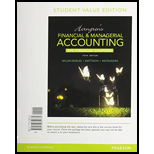
Concept explainers
Requirement 1
General Journal: It is a book where all the monetary transactions are recorded in the form of
Special Journal: It is a book where only specific type of monetary transactions such as cash receipts, cash payments, credit sales, and credit purchases are recorded.
Purchase Journal: Special Journal is a book where only specific type of monetary transactions such as cash receipts, cash payments, credit sales, and credit purchases are recorded. Purchases journal records credit purchases transactions.
Sales Journal: It is a special book where only sales transactions that are sold to customer on credit are recorded.
Cash Receipts Journal: It is a special book where only cash receipts transactions that are received from customers or other sources are recorded.
Cash Payments Journal: Cash payment journal is a form of special journal book which records the cash payments transactions which are being paid to suppliers or other sources.
To open: Four - column general ledger accounts using O’s account numbers and balances as of May 1, 2016.
Requirement 2
To open: Four-column accounts in the subsidiary ledgers with beginning balances.
Requirement 3
To enter: The transactions in a sales journal (page 7), a cash receipts journal (page 5), a purchase journal (page 10), a cash payment journal (page 8), and a general journal (page 6).
Requirement 4
To post: The accounts receivable subsidiary ledger and to the accounts payable subsidiary ledger.
Requirement 5
To total: The debit and credit column’s of the sales journal.
Requirement 6
To prepare:
Want to see the full answer?
Check out a sample textbook solution
Chapter C Solutions
Horngren's Financial & Managerial Accounting, The Financial Chapters, Student Value Edition (5th Edition)
 College Accounting (Book Only): A Career ApproachAccountingISBN:9781337280570Author:Scott, Cathy J.Publisher:South-Western College Pub
College Accounting (Book Only): A Career ApproachAccountingISBN:9781337280570Author:Scott, Cathy J.Publisher:South-Western College Pub College Accounting (Book Only): A Career ApproachAccountingISBN:9781305084087Author:Cathy J. ScottPublisher:Cengage Learning
College Accounting (Book Only): A Career ApproachAccountingISBN:9781305084087Author:Cathy J. ScottPublisher:Cengage Learning Financial And Managerial AccountingAccountingISBN:9781337902663Author:WARREN, Carl S.Publisher:Cengage Learning,
Financial And Managerial AccountingAccountingISBN:9781337902663Author:WARREN, Carl S.Publisher:Cengage Learning, Financial Accounting: The Impact on Decision Make...AccountingISBN:9781305654174Author:Gary A. Porter, Curtis L. NortonPublisher:Cengage LearningPrinciples of Accounting Volume 1AccountingISBN:9781947172685Author:OpenStaxPublisher:OpenStax College
Financial Accounting: The Impact on Decision Make...AccountingISBN:9781305654174Author:Gary A. Porter, Curtis L. NortonPublisher:Cengage LearningPrinciples of Accounting Volume 1AccountingISBN:9781947172685Author:OpenStaxPublisher:OpenStax College College Accounting, Chapters 1-27AccountingISBN:9781337794756Author:HEINTZ, James A.Publisher:Cengage Learning,
College Accounting, Chapters 1-27AccountingISBN:9781337794756Author:HEINTZ, James A.Publisher:Cengage Learning,





